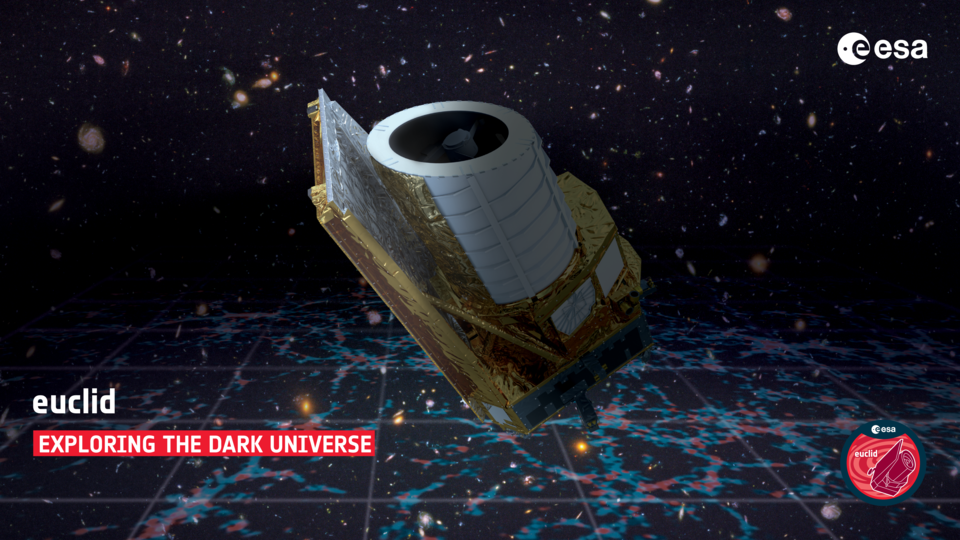Euclid Mission for Dark Matter and Dark Energy | 17 Nov 2023
Why in News?
The Euclid mission by the European Space Agency (ESA) launched in July 2023, to study dark matter and dark energy has shared its initial five science images which include pictures of expansive galaxy clusters, detailed shots of two nearby galaxies, a nebula, and a gravitationally connected group of stars known as a globular cluster.
Euclid Mission:
- ESA's Euclid mission is a space telescope designed to explore the composition and evolution of the dark Universe.
- Euclid will explore how the Universe has expanded and how structure has formed over cosmic history, revealing more about the role of gravity and the nature of dark energy and dark matter.
- Launch Vehicle: SpaceX Falcon 9
- Destination: Sun-Earth Lagrange point 2
What are the Different Findings by Euclid’s Mission?
- The Perseus Cluster: A Glimpse into Cosmic Depths:
- Euclid's lens focused on the Perseus Cluster, capturing 1,000 galaxies and over 100,000 more in the background, some situated 10 billion light-years away.
- The mapping of special attributes and characteristics of these galaxies will help unravel the role of dark matter in shaping the universe.
- Spiral Galaxy IC 342: Euclid's Infrared Revelation:
- Euclid's infrared capabilities provided valuable insights into the stars of IC 342, a spiral galaxy akin to the Milky Way useful for understanding galaxies with structures similar to our own.
- Irregular Dwarf Galaxy NGC 6822: Galactic Building Blocks:
- Irregularly-shaped and small galaxies like NGC 6822 play a crucial role as the building blocks for larger galaxies.
- Studying them sheds light on the formation of galactic structures.
- Globular Cluster NGC 6397 and the Horsehead Nebula:
- NGC 6397 is a nearly globe-shaped globular cluster about 7,800 LYs away.
- The mission showcased the Horsehead Nebula, aiming to uncover unseen Jupiter-mass planets in their early stages of development.
What is Dark Matter?
- About:
- Dark matter, though never detected, is believed to be present in the entire universe, its existence presumed because a number of observable celestial phenomena could not be possible if the universe did not have much more matter in it than is seen.
- It is believed to make up more than 95% of all the universe.
- Dark matter, though never detected, is believed to be present in the entire universe, its existence presumed because a number of observable celestial phenomena could not be possible if the universe did not have much more matter in it than is seen.
- Characteristics:
- The material is considered to be a ‘matter’ since it has gravitational attraction and it is ‘dark’ because it does not seem to interact with light (or any part of the electromagnetic spectrum).
- Its gravitational force prevents stars in our Milky Way from flying apart.
- However, attempts to detect such dark matter particles using underground experiments, or accelerator experiments including the world's largest accelerator, the Large Hadron Collider (LHC), have failed so far.
- The material is considered to be a ‘matter’ since it has gravitational attraction and it is ‘dark’ because it does not seem to interact with light (or any part of the electromagnetic spectrum).
Dark Energy:
- Dark energy is a hypothetical form of energy that is thought to permeate all of space and drive the accelerated expansion of the universe.
- It's a term used in cosmology to explain the observed phenomenon that galaxies are moving away from each other at an accelerating rate.
UPSC Civil Services Examination, Previous Year Question (PYQ)
Q. The efforts to detect the existence of the Higgs boson particle have become frequent news in the recent past. What is/are the importance of discovering this particle?
- It will enable us to understand why elementary particles have mass.
- It will enable us in the near future to develop the technology of transferring matter from one point to another without traversing the physical space between them.
- It will enable us to create better fuels for nuclear fission.
Select the correct answer using the codes given below:
(a) 1 only
(b) 2 and 3 only
(c) 1 and 3 only
(d) 1, 2 and 3
(b) 2 and 3 only
(c) 1 and 3 only
(d) 1, 2 and 3
Ans: (a)
Q. In the context of modern scientific research, consider the following statements about ‘IceCube’, a particle detector located at South Pole, which was recently in the news: (2015)
- It is the world’s largest neutrino detector, encompassing a cubic kilometre of ice.
- It is a powerful telescope to search for dark matter.
- It is buried deep in the ice.
Which of the statements given above is/are correct?
(a) 1 only
(b) 2 and 3 only
(c) 1 and 3 only
(d) 1, 2 and 3
(b) 2 and 3 only
(c) 1 and 3 only
(d) 1, 2 and 3
Ans: (d)

